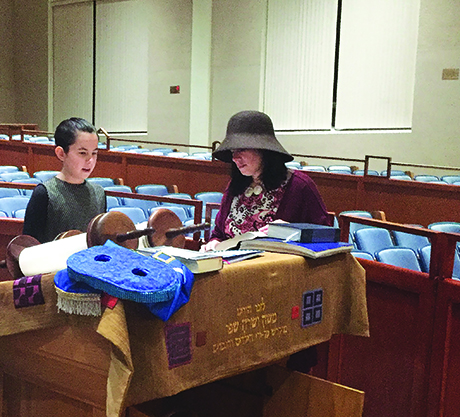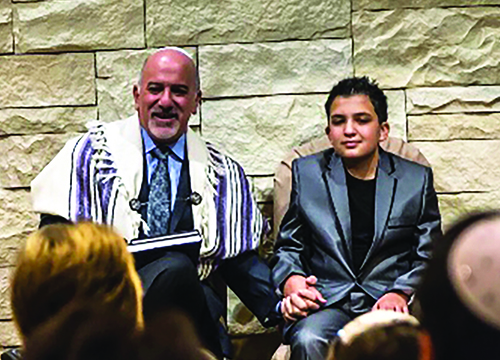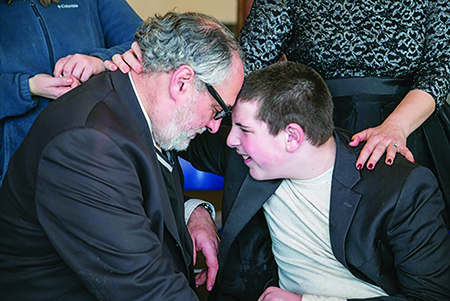Being Jewish
B’nei Mitzvah With Disabilities Find Their Way to the Bimah

Batya Sperling-Milner stood at the bimah of Ohev Sholom in Washington, D.C., last January, ready to chant her entire portion as a bat mitzvah. The synagogue is one of the few modern Orthodox congregations that allow women and girls to read Torah on Shabbat morning. In a navy blue dress, her left hand hennaed to look like a Torah pointer and her shiny brown hair pulled back into a bun, she placed the blue binder that contained her Braille humash next to the open scroll. Her voice soared confidently as her fingers flew over the 106 verses from Exodus describing the plagues, including the plague of darkness.
Batya, who has been blind since birth, learned to chant the Torah and haftarah through an innovative Braille cantillation system (trope) developed just for her. The humash she used on the bimah, however, only had the words of the Torah—just as in the scroll.
“My bat mitzvah was definitely not like anyone else’s bat mitzvah,” says Batya, 13, a Hadassah member like her mother, Rabbanit Aliza Sperling, who was ordained at Yeshivat Maharat, the Orthodox institution in Riverdale, N.Y. “There were some things that were the same, like people you don’t know coming up to you and saying, ‘Hi! I knew you when you were a baby!’ What was different was that I was leyning [chanting Torah] from Braille. Reading Torah is a big deal, and it’s amazing. I don’t think that there are ways to equal that spiritual experience in a shul. So I don’t think anyone should be denied that.”
Batya is one of an increasing number of children with a range of disabilities—from dyslexia and depression to autism and cerebral palsy—who are celebrating their b’nei mitzvah. While some adolescents with disabilities have celebrated the coming-of-age ritual in the past, a new understanding of diversity, disability and inclusion has opened doors in many more synagogues across the country, augmented by technological advances. The learning for each student is different, depending on their abilities, their needs and their goals. Some have to work harder to read, some to sing and some to overcome social anxiety just to get on the bimah. A number use English transliterations and picture symbols in place of the Hebrew text. Others schedule celebrations on Rosh Hodesh Sunday mornings, Monday mornings or a Hanukkah weekday, when the Torah reading is shorter and there is less pressure than on Shabbat morning.
The URJ Ruderman Disabilities Inclusion Initiative, a partnership between the Union for Reform Judaism and the Ruderman Family Foundation, has designated close to 40 synagogues as “exemplar” congregations in the area of inclusive b’nei mitzvah. Stand-alone programs provide Jewish education and b’nei mitzvah preparation, and other organizations offer training and outreach to synagogues and educators. The Conservative movement’s Masorti Foundation in Israel has just published B’Chol Drachecha, an accessible Hebrew siddur for people with and without disabilities, and is raising funds to translate it into English. It includes repeating pictorial symbols, like a globe for ha-olam (the world), to convey meanings.
Jewish camps, with their less formal atmosphere, have long served as the sites for special needs b’nei mitzvah. For Asher Landrecht to recite the Friday night Kiddush in front of 200 friends and family members at Ramah Day Camp in Elkins Park, Pa., in August 2018 required a mastery of mind and body. Diagnosed with autism, sensory processing disorder and apraxia of speech, Asher is largely nonverbal. His body often twitches and shakes and needs to be calmed by touch with a soft brush. But through a Tap to Speak computer program, he learned to tap on each Hebrew word on his iPad, activating a voice recording and creating a flowing rendition of the prayer. The next day, Asher read seven lines of Torah through a similar process at Old York Road Temple-Beth Am, a Reform synagogue in Abington, Pa., that has earned URJ’s exemplar status. He danced the hora at the luncheon following the service.

“You could see the work he did—not only having to learn the prayers but to do it via computer,” says his mother, Victoria McGuigan, 56, an arts educator. “Having a bar mitzvah is an astounding accomplishment and a milestone in any child’s development, yet our kids have to work even harder just to maintain focus.”
Despite Asher’s disabilities, says McGuigan, “he was able to show us clearly his understanding of the portion. During his lessons, he was gleeful, jumping up and down in an uninhibited way, with a big laugh and huge smile. That was the most wonderful piece of all, to see Asher embody his own self-pride.”
Asher’s teacher, Bruce Sham, 64, a financial planner for families with children who have special needs, is also a devoted b’nei mitzvah teacher. The Hadassah Associate is co-founder with his wife, Hilde, a Hadassah member, of the Amanda Sham Resource Center for Children with Special Needs at Old York Road Temple-Beth Am. Among the 50 apps on his phone and iPad are a simple yes/no app with images of green and red Frisbees, a piano keyboard app and one with Hebrew letters that can be colored. The apps help the children get comfortable with Sham, provide incentives to touch the screen and begin the learning process.
Sham’s own daughter Amanda, now 38, has an intellectual disability caused by microcephaly, a condition she was born with that involves a smaller head size than is typical. When she was 8, Sham called his synagogue to discuss a bat mitzvah. “We were told there were no Jewish children with special needs,” he says, his outrage still palpable. “That’s because they were put away. Occupational therapy, which provides fine motor strategies, was not even an approved medical practice.” Sham hired a private therapist to work with Amanda, watched and studied the modalities that helped her, and he eventually adapted the strategies to Jewish education.
“Our mission is to teach the child according to his or her needs. They learn on a one-to-one basis,” Sham explains. He also helped found the first Birthright Israel trip in 2007 for young men and women with disabilities. (Past Hadassah president and current chair of Hadassah Magazine Marlene Post helped secure the funding.)
Batya Sperling-Milner was not afraid to address her blindness directly in her d’var Torah. “Of all the parshiyot in the entire Torah on which my bat mitzvah could have fallen, I got Bo, the only parsha that deals with none other than darkness. It must be a sign from Hashem,” she says. “Most people laughed. It kind of felt a relief to approach it in a comfortable way, in a funny way, in a ‘yeah, that’s me’ way. Sort of accept that blindness is just part of me. And it wasn’t the main subject or the main thing, but it wasn’t hidden, and I didn’t want it to be hidden.”
Batya’s family moved to Riverdale, N.Y., last August. Sperling, who teaches Talmud at Yeshivat Maharat, spent a year researching the Talmud to find a halachic precedent for a blind person to read Torah from Braille. The Braille trope system was designed by family friend and Israeli computer developer Danny Sadinoff. Hebrew Braille, which Batya learned when she was 7, places vowels next to the consonants. Instead of the special symbols in traditional cantillation that indicate accent, punctuation and melody, the Braille trope system adds two dots to the left of a letter, signaling that a change in melody is coming. Batya downloaded the file onto her Braille Note, which is like a Kindle with Braille buttons. The trope system, called BRITH, or Braille Representation Incorporating Ta’amei Hamikra, is available at brith.sadinoff.com.
“The fact that Batya leyned in shul was not only good for Batya—it was good for the whole shul,” says Sperling. “All of us need to be included in one way or another.”
Gabrielle Kaplan-Mayer, 48, director of the Whole Community Inclusion Program at Philadelphia’s Jewish Learning Venture, knows the challenges of preparing children with disabilities for b’nei mitzvah both on a communal and personal level. Her organization launched an initiative in 2015 to train and mentor professionals to prepare b’nei mitzvah students and has conducted sessions in Philadelphia and New York City.

Her own son, George, has autism and intellectual disabilities and is nonverbal, but capitalized on his musical and visual skills when he celebrated his bar mitzvah on Martin Luther King’s Birthday last January, a Torah-reading Monday that coincided with his 13th birthday. One creative element of his service was a slide show depicting his connection to nature with photos of George on different nature walks. “Sometimes we focus on the challenges and forget the strengths,” Kaplan-Mayer says.
In Newton, Mass., a group of parents who wanted their children to have a Jewish education established Etgar L’Noar in 1999. Today called Gateways: Access to Jewish Education, the program offers a two-year b’nei mitzvah training for students with special needs that draws children from all denominations. “The kids do tefillah with such ruach,” says Rebecca Redner, 33, educational specialist and b’nei mitzvah coordinator. Students spend 45 minutes each session working one-on-one with their tutors, decoding the prayers and Torah portions, followed by a group lesson. Some use communication boards with symbols and pictures to read prayers and learn, review and understand information. (The Gateways siddur also uses picture symbols and English translations.) Others lead prayers through tapping the correct symbols on a tablet that activate the voices of their teachers.
The students’ d’vrei Torah are also individualized. Mira Weisskopf, who has cerebral palsy, attended Gateways for six years in her bright pink wheelchair before her bat mitzvah in 2014. She prepared a project on strong Jewish women, using an iPad communication board with questions like, “Tell me about a time you were brave?” The 13 interviews she conducted with her teachers, her grandmother and more were turned into a book. Her d’var Torah focused on the same theme.
While Gateways is a special-needs-only program, some synagogues and organizations have created inclusive programs. At Congregation Or Ami in Calabasas, Calif., another URJ exemplar congregation, children with disabilities are integrated with other children, echoing the trend in general education. “Everyone was present at Sinai, including people with special needs,” says Rabbi Paul Kipnes, 55, who runs the b’nei mitzvah program. “You come with the kid and we work with you. It’s so ‘non-special’ that I don’t even notice it anymore,” he adds, noting that he has taught a child with autism to sound the shofar and another who is deaf to sign his Torah portion. Adaptability and creativity are key, he says. However, experts emphasize that it is also essential that educators have the right training and tools available to ensure that all the children involved in an integrated classroom benefit—not just those with special needs.
For his part, Kipnes held hands on the bimah with Jacob Gilbert, who has autism, sensory disorder, intellectual disabilities and social ineptness and needs touch pressure to calm his body. Jacob’s teacher held his arm and rubbed his back when he chanted Torah, haftarah and other prayers, and when Jacob sat down, he interlaced hands with the rabbi’s. It brought everyone to tears, says his mother, Heather Gilbert-Bakalor, 45, an early childhood educator.
Jacob is now in the synagogue’s youth group. “His bar mitzvah was the shining moment of his life,” his mother says. “It opened up his potential. He knows what he’s capable
of now.”
Rahel Musleah, a frequent contributor to Hadassah Magazine, leads tours of Jewish India and speaks about its communities.










 Facebook
Facebook Instagram
Instagram Twitter
Twitter
Sheila K. Lewis says
Thank you, Rahel, for this important article. My son, now 35, who has autism, was bar mitzvahed at our egalitarian, Conservative synagogue. Bright, extremely musical and proficient in trop, he had behavioral challenges that made his big day an extraordinary challenge. Along with his tutor, the “normal” ed
Havurah school, and a caring community, he did more than fine. However, the road to acceptance of certain kinds of disabilities (and not others), is still rocky and painful for individuals and their families.
As a young adult now living in a group home in Riverdale, NY, my son is one of many adults who attend amazing social programs at one institution, the Orthodox HIR, Hebrew Institute of Riverdale. Too few of these programs, or avenues of support, not to mention group homes or communities like those described that exist in Israel, take root in the U.S, and in large, metropolitan areas like New York.
It’s time that more awareness and funding throughout the Jewish community grow, so that needed services, including residential, can flourish for this often hidden population.
Sincerely,
Sheila K. Lewis
Parent Advocate, Jewish Educator
New York, NY
Myra Shaughnessy says
I was denied an Aliyah because the conservative synagogue did not have a ramp to go up to the bima. I have Parkinson’s. It was at my cousin’s Bat Mitzvah